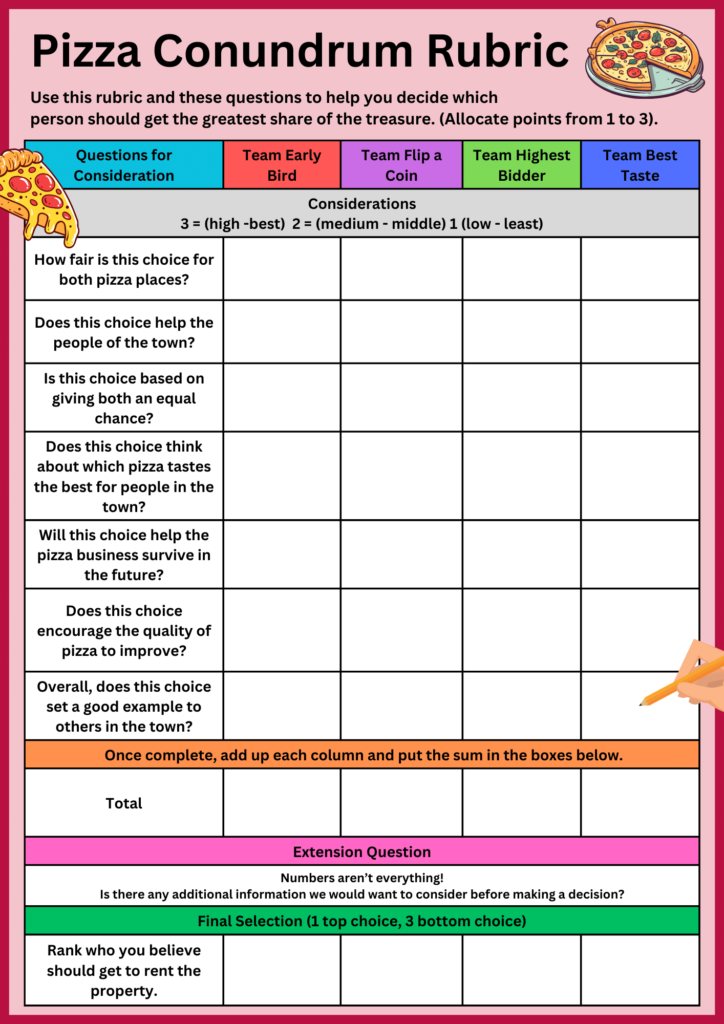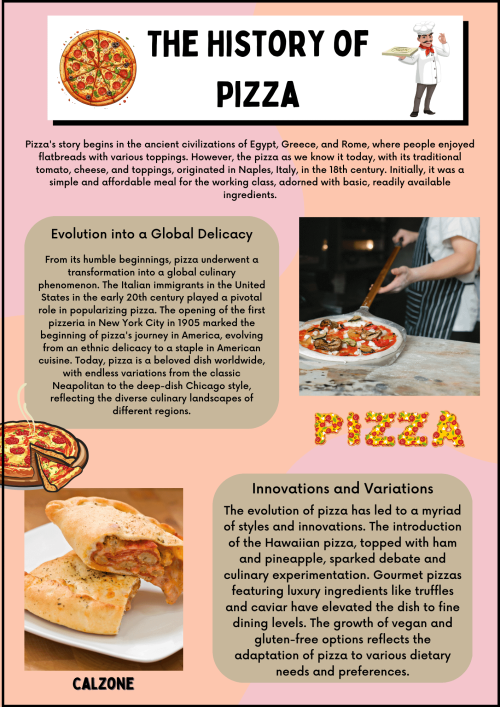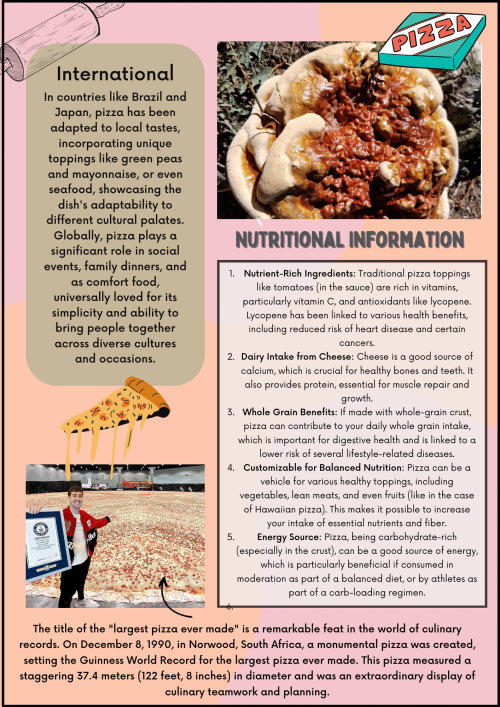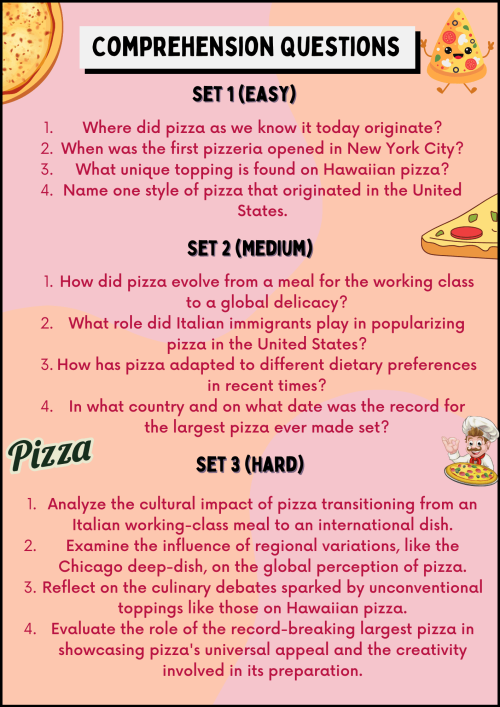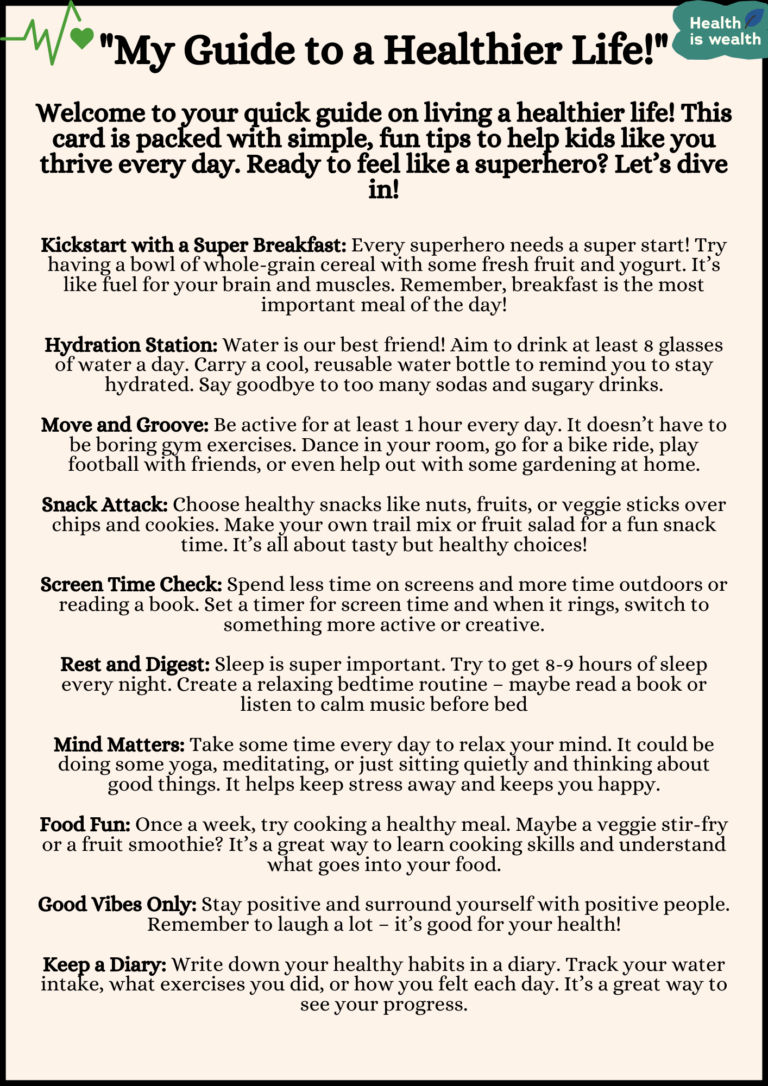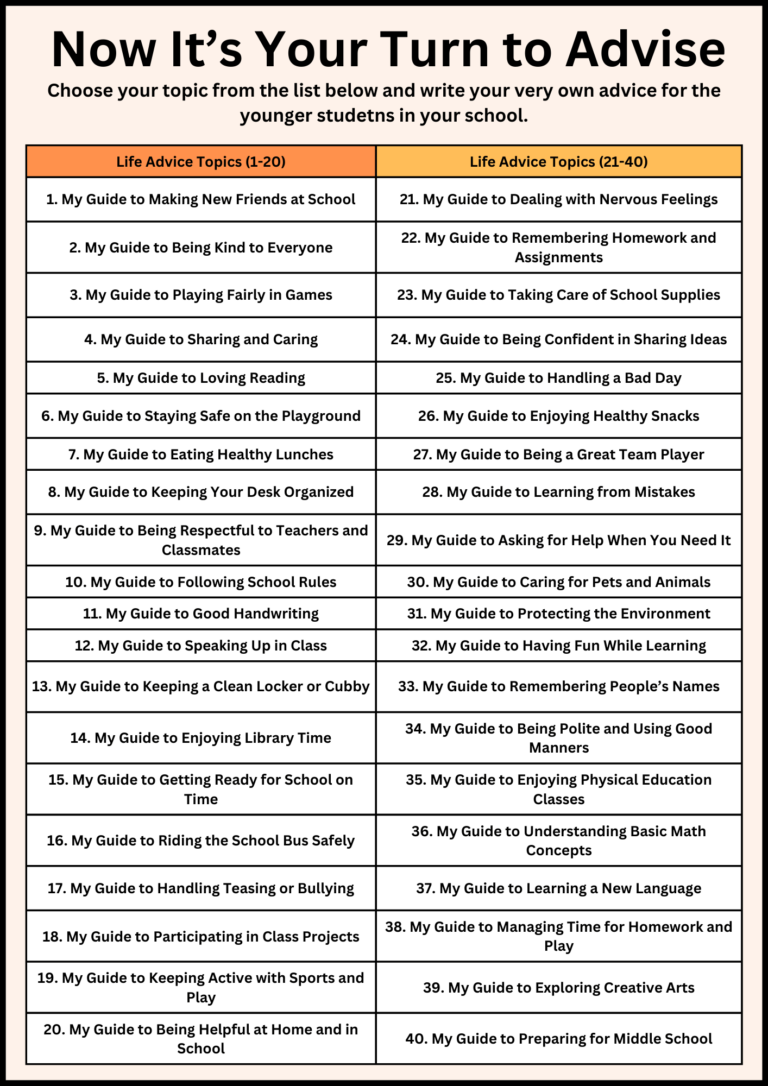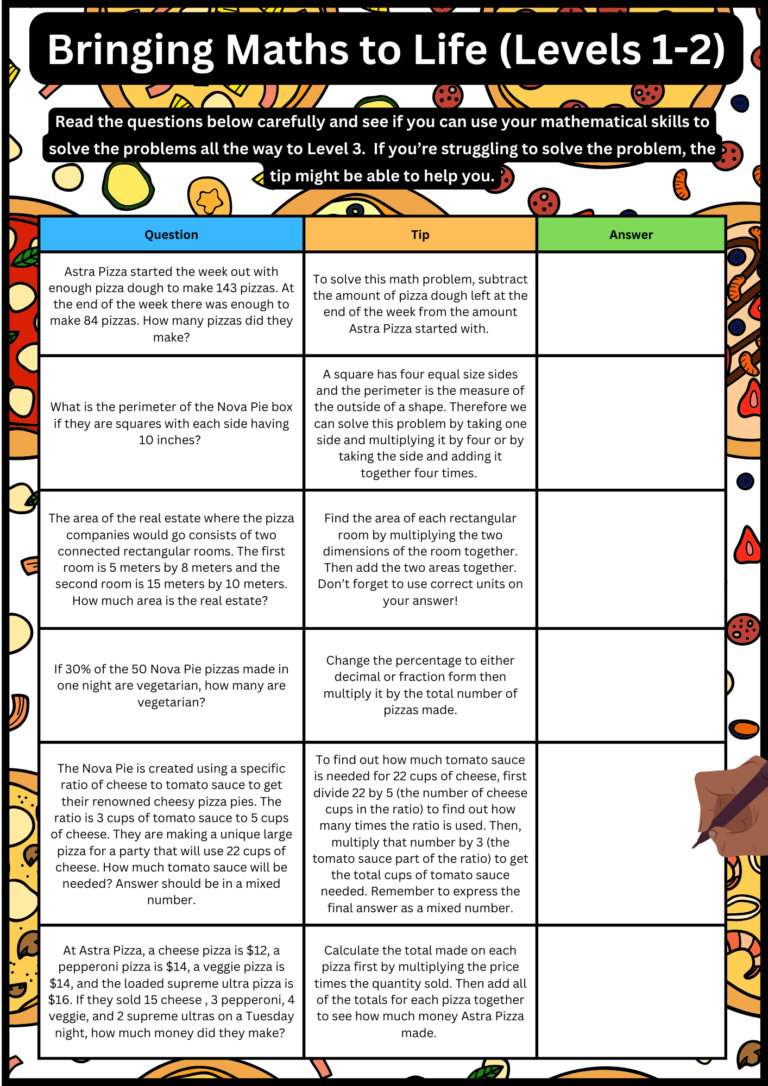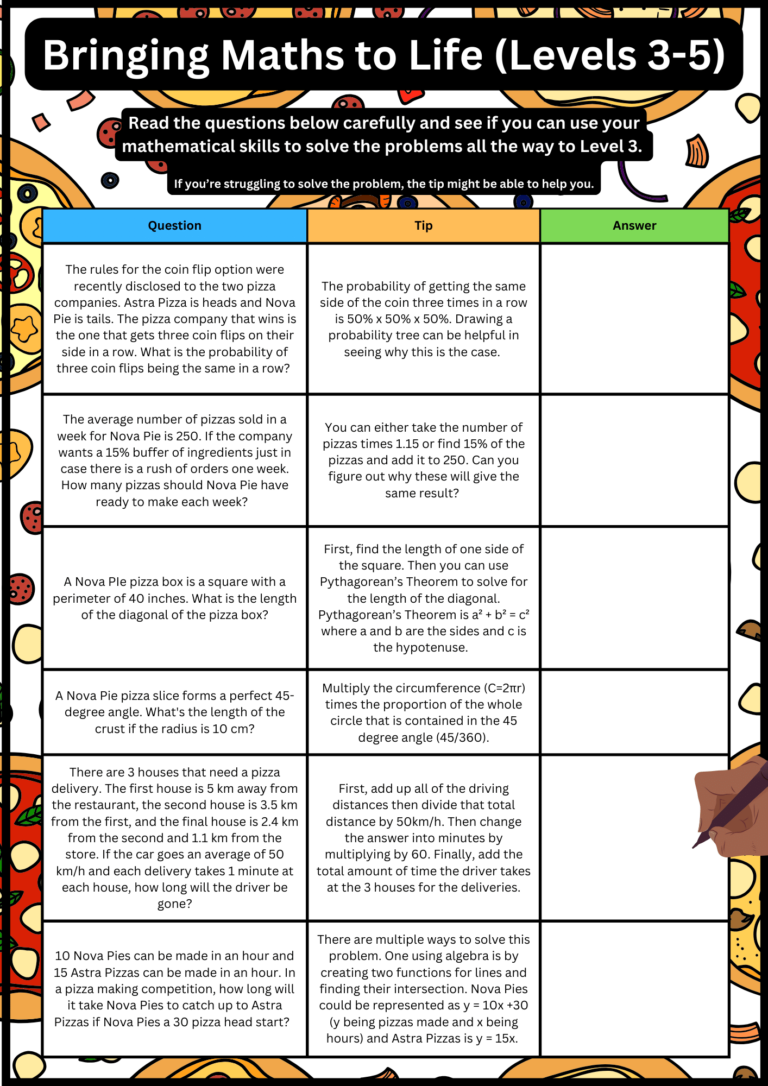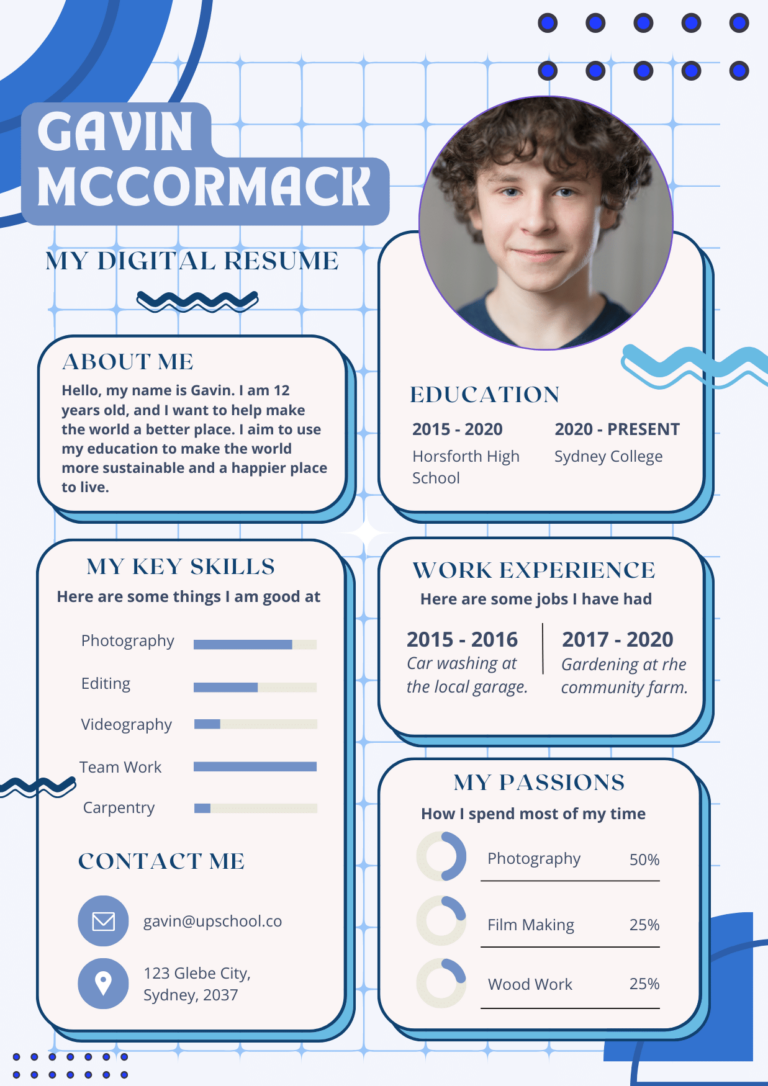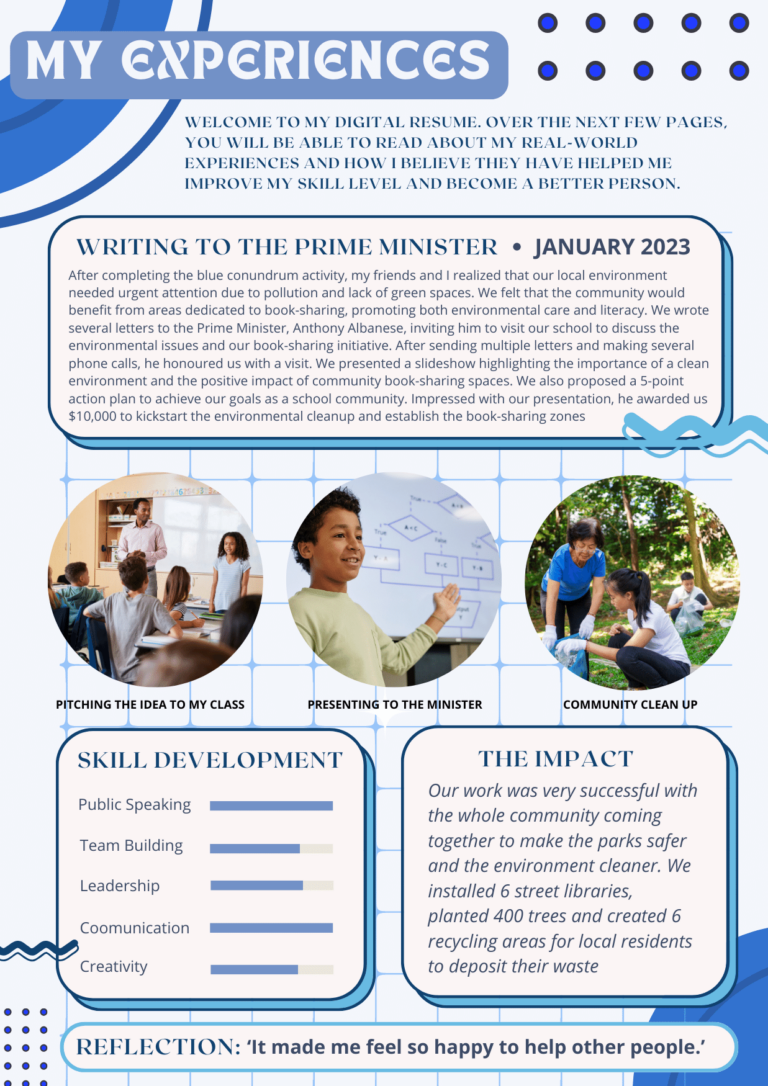Introduction
In this lesson, students evaluate a scenario where two pizza places, Astra Pizza and Nova Pie, compete for a single town location. They must decide between four options: Early Bird, Flip a Coin, Highest Bidder, or Best Taste. The focus is on developing critical thinking and decision-making skills, encouraging students to analyze fairness, strategy, and ethical implications. Discussions, hands-on activities, and digital projects are utilized to deepen understanding and apply economic and ethical concepts in a practical context.
Learner Notes
Hello everyone! Today’s lesson brings an intriguing challenge: deciding between two competing pizza places, Astra Pizza and Nova Pie, both eager to occupy the same location in a bustling town. This scenario is a perfect springboard into the world of decision-making and economic strategy.
As we delve into this conundrum, I encourage you to engage critically. Note down your initial thoughts and questions. Are you leaning towards Team Early Bird, Team Flip a Coin, Team Highest Bidder, or Team Best Taste? Your notes will be invaluable in our discussion.
Following the scenario presentation, we’ll have a rich discussion. This is your platform to express your viewpoints and reasoning. Whether it’s about fairness, business strategy, or sheer luck, every perspective is crucial and there are no wrong answers.
But we’re not just talking; we’re doing. We’ll translate this scenario into engaging, real-world activities that will deepen your understanding of economic concepts and ethical considerations in decision-making.
And for those who enjoy creative expression, you’ll have the chance to craft a digital project. This will help you consolidate your learning and articulate your perspective on the scenario.
So, prepare for an enlightening session where lively debate, practical activities, and creative thinking come together. Let’s dive into the fascinating dynamics of choice and consequence in the real world!
Attention to Detail Challenge
This activity involves students re-watching a video to enhance their observation skills. They pair up, list numbers 1-15, and discuss before answering questions within a 20-second time limit.
It’s designed to encourage teamwork, quick thinking, and attention to detail, while also fostering a learning environment where practice leads to improvement and building the muscle of paying attention to detail.
Learner Notes
Having watched the video again, it’s time to gauge your powers of observation.
Pair up with someone, and once you’ve got a piece of paper and a pencil, list the numbers 1-15 to start.
Keep in mind, you can discuss with your partner prior to settling on your response, but you’ll only have 20 seconds to decide. Watch the clock in the upper right corner to track your remaining time.
Best of luck, and don’t stress over any mistakes – remember, improvement comes with practice.
Make up your Mind - Rubric and Discussion
This lesson engages our students in a decision-making exercise, focusing on a scenario where two pizza places compete for one shop space.
Emphasizing discussion, students use a rubric to evaluate options based on fairness, economic impact, and ethics. It encourages critical thinking about numerical evaluation and moral considerations in decision-making.
Learner Notes
Let’s pair up and dive into an engaging challenge! You’ll be considering four different ways the town could choose between two pizza places, Astra Pizza and Nova Pie, who both want the same shop space. With your partner, you’ll explore which method seems the fairest or best and why.
During your discussion, use the provided rubric to guide your thoughts:
Identify the reasons why you think your chosen method (Early Bird, Flip a Coin, Highest Bidder, or Best Taste) is the best way for the town to decide.
Discuss why the other three methods might not be as effective or fair in this situation.
Reflect on how your choice might relate to real-life decisions and fairness in our society.
After a thorough discussion, we’ll come back together as a class. Each pair will share their viewpoints, and then we’ll open up for a wider class discussion. This will be an excellent chance to see how different methods are viewed and understood by everyone.
Weekly Keywords
Introduce the spelling word list and choose from this list of tasks that can be repeated and expanded upon if necessary. Copy the words into a spelling list/Vocabulary book for later reference. Put each of the new words into a sentence and underline the new vocabulary in red pencil or pen. Place the words in alphabetical order in a list. Use a dictionary to define each of the words and place them into a vocabulary book.
Learner Notes
These words will help you during this week’s lesson. You may already know some of these words, however vocabulary practice is always useful!
First, read the words and then try to define them as simply as possible.
An example has been completed for you. You can write these into your books, and draw a picture to match or simply complete the task card.
Weekly Comprehension Activity - The History of Pizza
In this lesson, students explore the history of pizza, enhancing reading comprehension and promoting independent learning. They engage with a tiered text, catering to various skill levels.
The focus is on understanding, analyzing, and reflecting on the material, with an emphasis on applying these skills to answer progressively challenging questions independently.
Learner Notes
Read the provided information on the history and evolution of pizza, from its origins to the creation of the world’s largest pizza. Utilize the knowledge gained from our previous discussions and any relevant resources to try answering the comprehension questions.
Collaboration with your classmates is encouraged, and you’re welcome to use any available classroom materials to assist in your research. If certain questions prove challenging, consider exploring more about the topic at home.
The questions are structured to cater to a range of difficulty levels, offering an engaging and educational experience. Challenge yourself to answer as many as you can accurately! Remember to answer in complete sentences and make notes of any interesting facts, regional variations, or key historical milestones.
These notes will be useful for recalling details and enhancing your overall understanding of pizza’s rich cultural and culinary history.
Guided Writing - Writing Advice
This lesson engages students in purposeful writing by having them create advice guides for younger peers. Choosing from a list of relevant topics, students apply their experiences to craft clear, concise, and engaging content.
This exercise emphasizes clear communication, empathy, and relatability, aiming to enhance students’ writing skills, foster mentorship, and encourage reflection. It’s a practical approach to developing writing proficiency, with a real audience and purpose in mind.
Learner Notes
This week, we’re stepping into the role of mentors for younger students. Your task is to choose one topic from our “Advice Topics for Younger Children” table and write an engaging piece of advice or a mini-guide on that topic.
Here’s How to Get Started:
- Choose Your Topic: Pick a topic from the table that resonates with you or where you feel you can offer great advice.
- Read My Example: I’ve written a sample guide on “My Guide to Making New Friends at School” to give you an idea of how to structure your piece. Please read it before you start writing.
- Write Your Own Guide: Create a helpful, fun, and engaging guide for younger students. Your guide should be clear, positive, and encouraging.
Remember These Key Points While Writing:
- Be Clear and Concise: Use simple language that younger children can easily understand.
- Be Relatable: Share personal experiences or stories that younger children can connect with.
- Be Positive and Encouraging: Your advice should inspire and motivate younger students.
- Use Engaging Examples: Include examples or scenarios that make your advice practical and actionable.
Writing never felt this good!
Bringing Mathematics to Life!
For each conundrum, we will provide related mathematics questions
The levels of questions allow for your students to push themselves until they become too difficult. They may wish to use classroom resources to solve the questions they find too hard or they can be used as extension activities to be completed in free time or at home.
Learner Notes
This week’s problem set centers around the characters from the Pizza Conundrum. Learn a bit more about the characters and their adventure by solving some Math problems in the task card.
If they get too hard you can either ask a friend, use the tip provided in the middle column to help you, or take your work home and work on solving the problems at home with your family!
Real World Learning - Creating a Presentation and Teaching a Class
In this lesson, students apply their life advisory skills to create digital presentations for younger audiences. They are tasked with designing slide decks, integrating text, images, and graphics.
This activity emphasizes creative design, digital literacy, and the skill of conveying complex concepts in concise, child-friendly language. It’s an engaging way to practice digital storytelling and instructional design, preparing students for effective communication and teaching. The goal is to positively impact younger peers through well-crafted, meaningful content.
Learner Notes
Now that you’ve become an advisor in life, your task is to share this expertise with a younger class of children.
To capture the attention of these younger students, create an engaging slide deck to aid in teaching your concept.
Drawing on your new knowledge, craft your own slideshow with text, images, and graphics. Once prepared, present it to a class of younger children, guiding them towards a better, happier life.
Writing has never been more fun and meaningful. You’re making a positive impact on the world!
Well done!
Real World Application - Performing Market Research
In this lesson, students will do market research on pizza stores in their neighborhood. They will dig into prices, location, and ratings from the internet to create a structure for deciding which pizza restaurant they recommend. We have provided an example but as always we encourage students to take this concept and make it their own.
The important theme here is that we can gather information from the world around us in order to make better decisions. A good hook may be telling a story to students about a time where you had to make a decision between which restaurant to go to. This sort of analysis can help. If you are working with younger students, providing more structure (i.e. selecting the restaurants they will look at, or the measures they will obtain) may be a good choice. For older students, they can branch out and create their own measures and identify their own sample of restaurants!
Learner Notes
In this activity, we will begin to do some market research on the Pizza Market in our neighborhoods. We will research online to find information about a handful of different pizza restaurants. From there, we will use an analytical approach to deciding which pizza restaurant we like best.
As an optional extension, you can taste the benefits of your work and enjoy the best pizza you could find by ordering pizza from the winning restaurant!
(If you don’t have Pizza restaurants in your neighborhood, feel free to choose another restaurant type or store!)
My Digital Resume
This task involves students reflecting on their recent learning experiences and skills gained. They are encouraged to update their digital resumes, incorporating multimedia elements for a comprehensive self-assessment.
This activity promotes introspection and self-evaluation, helping students recognize and articulate their progress and achievements. It’s a practical exercise in documenting personal growth and impact, fostering a deeper understanding of their developmental journey and its significance in their lives.
Learner Notes
Welcome to week three of our exciting journey! Reflect on the progress you’ve made and the skills you’ve acquired.
This week, enhance your digital resume by adding these new experiences. Spice it up with photos and videos for a dynamic touch.
Make sure to note down each skill you’ve mastered. Your continued enthusiasm is key as we move forward together!
This evolving resume will be a lifelong testament to your impact and growth. It’s not just a document, but a story of your positive changes in the world.
Great job!




